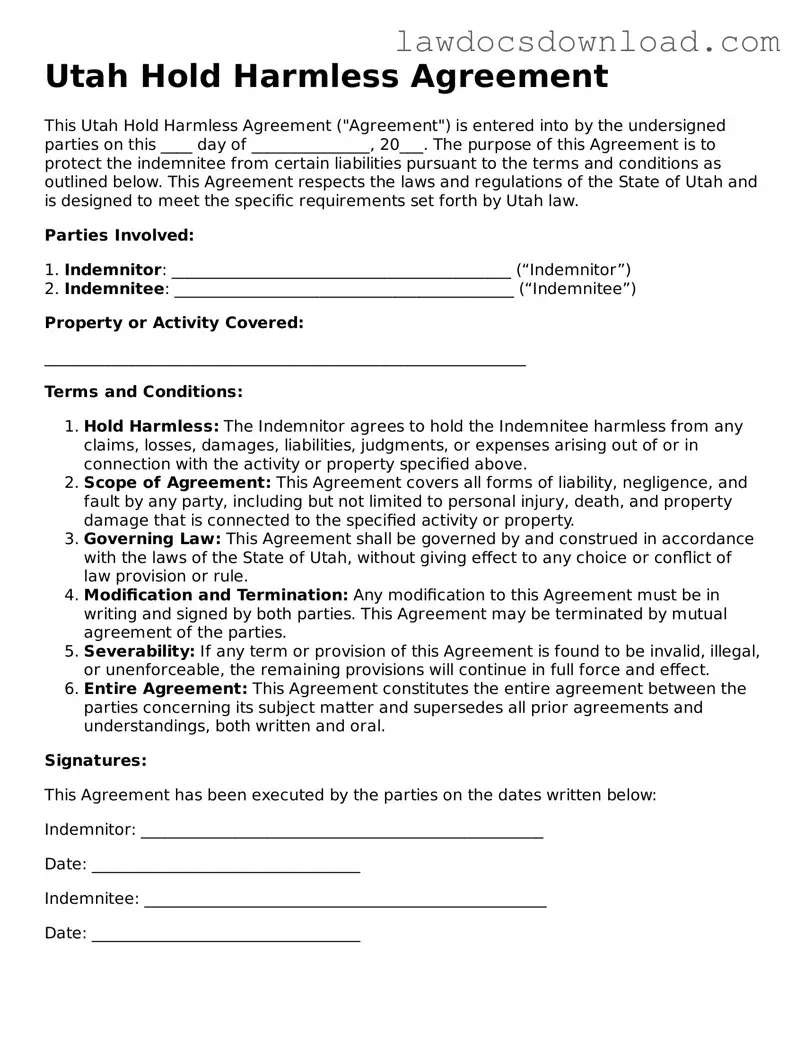The Utah Hold Harmless Agreement form shares similarities with a Waiver of Liability form. Both are legal documents designed to protect one party from legal claims or liabilities arising from a certain activity or event. In a Waiver of Liability, participants agree not to hold the organization or individual responsible for any injuries or damages they might suffer. Similarly, in a Hold Harmless Agreement, one party agrees not to hold the other liable for any losses or damages. These documents are commonly used in events that carry risks, such as sporting activities or construction projects.
Indemnity Agreements are also related to Utah's Hold Harmless Agreement form. An Indemnity Agreement is a contract where one party agrees to compensate another for the harm or loss arising out of specific incidents. It's akin to a Hold Harmless Agreement in its function to transfer risk and protect against liability. However, the emphasis on compensation for loss is more pronounced in an Indemnity Agreement, which usually involves financial reimbursement.
A Release of Liability form is another document with a close resemblance to the Hold Harmless Agreement. This form is commonly used when one party is being released from responsibility for any injuries or accidents that may occur to another party. It’s a mutual agreement where, for example, participants in an activity acknowledge the risks involved and agree not to hold the organizers responsible. Both documents serve the purpose of protecting individuals or entities from lawsuits related to accidents or injuries.
Non-Disclosure Agreements (NDAs) share a conceptual similarity with the Hold Harmless Agreement, in the sense that both aim to protect one's interests through a legally binding agreement. NDAs are designed to safeguard sensitive information from being disclosed, while Hold Harmless Agreements are about protecting oneself from liability. Though they serve different ends—confidentiality vs. liability protection—both establish a formal understanding between parties about their respective rights and obligations.
Property Use Agreements resemble the Hold Harmless Agreement in their purpose to outline the terms under which one party can use another party's property. These agreements often include provisions that protect the property owner from liability for injuries or damages that might occur on the property, similar to how a Hold Harmless Agreement works to protect one party from legal claims stemming from specific actions or events. Both agreements facilitate a mutually beneficial arrangement while addressing the potentials for risk and liability.
Construction Contracts can have elements similar to those found in a Hold Harmless Agreement, especially in clauses that pertain to liability and risk management. These contracts typically govern the relationship between a property owner and a contractor, defining the work to be done, timelines, and payment terms. They also often include indemnification or hold harmless provisions to protect the property owner from claims related to the construction activities. This leads to a shared goal of managing risk and clarifying responsibilities regarding safety and insurance.
Event Sponsorship Agreements, while primarily focusing on the commercial aspects of event sponsorship, occasionally incorporate clauses similar to those in Hold Harmless Agreements. An organizer might include such a provision to ensure that the sponsor is not held accountable for certain liabilities or damages during the event. This mutual understanding helps both parties manage risks associated with large gatherings, ensuring a clear delineation of responsibilities.
Volunteer Agreements are used by organizations to outline the expectations and responsibilities of volunteer work. Like the Hold Harmless Agreement, they often include clauses that release the organization from liability related to the volunteer’s activities. These agreements ensure that volunteers clearly understand the risks involved in their work and agree not to hold the organization responsible for any harm or losses they might incur while volunteering.
Employment Contracts, specifically those that include non-compete or non-solicitation clauses, share a spirit of protection with Hold Harmless Agreements. While focusing on employer-employee relationships and aimed at protecting business interests, these contracts include provisions to minimize potential harm to the business. Similar to a Hold Harmless Agreement's function to waive liability, non-compete clauses protect a company’s interests by restricting certain activities of the employee, both during and after the period of employment.
Lastly, Equipment Rental Agreements often contain language similar to that of Hold Harmless Agreements, especially regarding the user's responsibility for damage or injury arising from using the equipment. These agreements make it clear that the renter assumes all risks associated with the equipment's use, protecting the owner from potential legal claims. Both types of agreements are vital for clarifying terms and conditions, reducing misunderstandings, and safeguarding against unforeseen liabilities.
